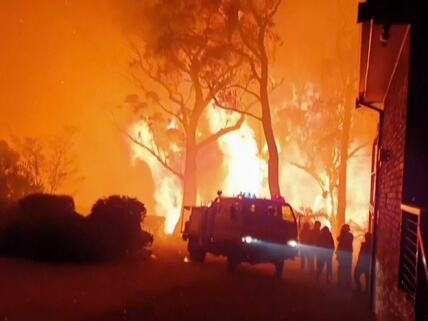A fire brigade in New South Wales, Australia, fights a raging bushfire, December 2019.
Australia’s worst wildfires in decades met with heavy rainfall in February and have finally been brought under control. Upwards of 15 inches of rain fell in Sydney, three times the monthly average. Melbourne received a month’s worth of rain in a single day. “Megablazes” that were deemed “too big to put out” were extinguished. Although the resulting flooding brought devastation, the rains replenished the region’s water supplies—welcome relief after years of drought.
The year 2019 was the continent’s hottest and driest on record. A heatwave in December (summer in the Southern Hemisphere, don’t forget) broke average-temperature records nationwide. These conditions made it easier for fires to start and spread. Although most of the fires were ignited by lightning strikes, officials also have charged two dozen Australians with arson. In all, the bushfires burned 15–25 million acres of land and destroyed or damaged more than 3,000 homes. The extent of damage is many times the acreage that burned in 2018 in California’s record wildfires.
The bushfires killed at least 30 people and around a billion animals, including birds, reptiles, and mammals (except bats)—and not counting insects and frogs. Many of Australia’s biodiverse habitats and sensitive ecosystems have been destroyed. The continent is home to some of Earth’s most distinctive animals, like marsupials. One estimate says nearly one-third of Australia’s koalas may have perished in the fires.
Bushfires raged in every Australian state, with the worst-affected areas being in the east and south, especially New South Wales (NSW), the country’s most populated state. As bushland and forests burned, strong winds pushed the fires and spread the smoke into urban areas. At the peak, Sydney’s air quality was 11 times the “hazardous” level. As plumes of smoke rose into the atmosphere, the effects were felt in New Zealand and southern South America.
Many scientists agree that climate change is making such natural disasters worse. Australia’s fire season is beginning earlier, and fires are spreading with greater intensity. Given that this year’s severe fire season did not coincide with the warming of an El Niño pattern, more such extreme fire events are likely in Australia’s future.
Image credit: © Ingleside Rural Fire Brigade/AP Images
Related Links:
- Rains Douse Australia Fires, but Produce Severe Flooding
Torrential rains bring long-awaited drought relief.
(Source: UPI.com, February 10, 2020) - Sydney Rains: Record Rainfall Brings Flooding but Puts Out Mega-blaze
Massive relief from fires arrives in Sydney and New South Wales.
(Source: BBC News, February 10, 2020) - 8 Things Everyone Should Know about Australia’s Wildfire Disaster
Article explains reasons for the damaging wildfires, including short-term weather patterns.
(Source: Vox.com, January 22, 2020) - Yes, Climate Change Did Influence Australia’s Unprecedented Bushfires
Assessment of the connection of global warming to the wildfires in Australia.
(Source: Scientific American, March 4, 2020) - Australia Wildfires Are Showing No Signs of Stopping: Here’s What You Need to Know
Report on the Australian bushfires covers loss of wildlife; includes links to charitable organizations.
(Source: CNN.com, January 13, 2020) - Ten Impacts of the Australian Bushfires
Assessment by the United Nations Environment Programme.
(Source: UNEP, January 22, 2020) - Australia: Extreme Weather in Pictures
Photo gallery of recent extreme weather conditions in Australia—dust storms, floods, and hail, not just bushfires.
(Source: BBC News, January 20, 2020)




